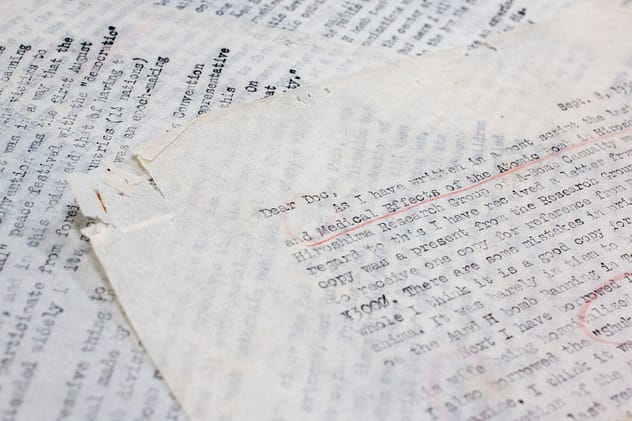“In 1957, as atomic bomb survivors continued to die mysteriously of unknown causes — and fierce debate raged about whether or not to preserve the artifacts of the bombing (including the Atomic Bomb Dome itself) — Austrian author Robert Jungk, aided by Ogura, set out to discover the true stories of the A-bomb victims.”
Client: Japan Times, providing the latest news and features from Japan including business, politics, culture, entertainment, and more.
Project Description: Provide a feature article discussing the work of Kaoru Ogura, an interpreter and peace activist who lived in Hiroshima City, and the current efforts to translate more than 800 pages of his research notes into Japanese.
A Quote
“In 1957, as atomic bomb survivors continued to die mysteriously of unknown causes — and fierce debate raged about whether or not to preserve the artifacts of the bombing (including the Atomic Bomb Dome itself) — Austrian author Robert Jungk, aided by Ogura, set out to discover the true stories of the A-bomb victims.”
The Inside Scoop
I first heard of Kaoru Ogura’s research notes from his widow, Keiko. She had recently discovered them stuffed in an old drawer in her house, and was telling me about them after a screening of an NHK World documentary about her husband.
The documents in question amounted to more than 800 pages of frail carbon copies of typewritten letters sent in 1957 and ’58 from Kaoru Ogura to Austrian author Robert Jungk. The contents of the letters comprised the primary research for Jungk’s internationally acclaimed book about the bombing of Hiroshima, Children of the Ashes.
Fascinated, I asked Keiko if she would mind if I pitched an article to the Japan Times about her discovery of the letters, and naturally she said she’d be delighted. Apparently my editor at the Japan Times was delighted too, because he green lit me for a 2000 word feature piece (1400 word article with two 300 word featurettes), scheduled to hit print on August 2nd—just four days before the 72nd anniversary of the bombing of Hiroshima.
Admittedly, this was a pretty complex project. I had to meet with and interview the researchers, as well as Keiko, and compile photos from Keiko’s collection. I also had the honor of being the first foreigner to see the documents in person, and was permitted to peruse them and photograph them. As a testament to the depth of Mr. Ogura’s research, literally the very first page I cast my eyes on featured information so fascinating I wound up including it as one of the featurettes accompanying the main article (The Plea of the Victims).
One of the biggest challenges to this piece also stemmed from the sensitivity of much of the information contained within the letters—a fact I allude to in the article. In the piece I mention the struggle the researchers are going through in vetting the information before slating it for publication in their upcoming book. What I don’t mention is that my own writing for this piece underwent the same rigors, with the researchers checking not only my writing—but the photos I took of the documents—for any information unfit to be released to the public. Primarily this would be the names of individuals whose families and/or descendants do not wish to be associated with the atomic bombing, since there was—and to some extent still is—prejudice against the A-bomb survivors (for more info, read my article). Fortunately, my piece passed their inspection in the first round, so whatever forbidden secrets might lurk within those pages clearly evaded my attention.
In any case, this article was a great challenge, and an unbelievably fascinating piece to research and write. In fact, the hardest challenge stemmed not from choosing what information to include, but rather agonizing over which of the countless captivating details at my disposal I would be forced to leave out.
My Favorite Part
Being able to tell the stories of people involved in one of history’s most significant tragedies, and having the opportunity to share their efforts to promote peace.
See the results:
Hope After the Horror Revealed in Letters from Postwar Hiroshima


